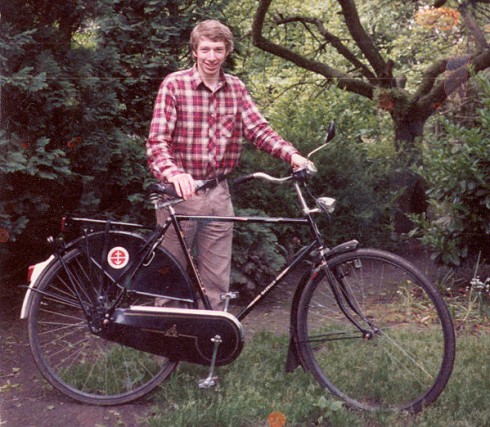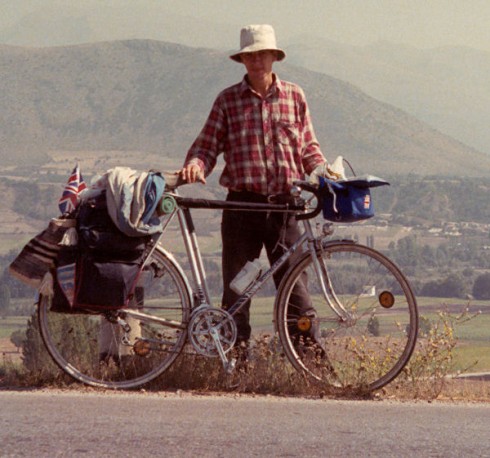Note from John Allen: Ian Cooper originally wrote the following essay as a counter-argument against the idea that there has never been a European bike culture, based on observations that did not extend beyond typical urban cycling on heavy, black bicycles.
I cycled throughout Europe in 1984 and 1985. I spent a year and a half there and covered 10,000 miles. I cycled through 13 countries, often together with locals.
There were three bicycling cultures in Europe at that time – as there have always been since at least WW2. There’s the culture of the family bike, there’s the culture of the hobby bike, and there’s the commuter bike culture. The family bike crowd kept their dad’s and mom’s bike in the basement – often it was heavy, old, cranky and rusty. It worked – barely, but it got them out doing errands every week or so when the family car wasn’t available. The ‘bike as a hobby’ culture used mid- to high-end bikes for weekend outings and tours. Then there was the commuter, and he needed an everyday bike that could go faster and had more gears than the family bike because he was on it every day for a good amount of time – so he chose the mid-range racing bikes too.
I have been a cyclist for 40 years – since I was 8 [in 1971, more or less]. In 1979 or 1980 I started commuting to work on a mid-range Peugeot road bike. This was in England. I was not a bicycle enthusiast – I was just a commuter, and as a commuter I needed a bike that was light, fast and maneuverable, and one that could get up hills. I did that for 4 years, 250 days a year, rain or snow.
My European trip started as a walking tour to Istanbul. In Holland I pulled a muscle in my foot and couldn’t go on. I met a family on the border between Holland and Germany and they loaned me a bike – a massive black thing (I still have a picture of it) and the family and I went for a ride – at 4mph through the Dutch countryside. Even though it was slow, it showed I could continue my journey because my foot could pedal without pain.
Now, I spent time with about 15 families during my tour. Most of them were like this one – they owned an old cranky ‘family’ bike but their main transportation was their car. I stayed with three families who owned at least one mid-range or high-end bike. They all owned a car too, but they were the ‘hobbyists’. I didn’t stay with any bike commuters that I remember – one may have been.
I set out for Cologne and sought out a bike shop. I asked the owner for a good touring bike for under $300. He steered me to a Motobecane Super Mirage (I still have a few pictures of it). Then I set off to Istanbul.
On my way (and on my way from Istanbul to Granada, and back to England again) I met very many cyclists, some on day trips, some foreigners like me on tours. But the local cyclists I met were much the same as the ones we see today on bike trails, some vacationing commuters with racers and some hobbyists with touring bikes (I don’t remember many mountain bikes back then – some Americans and Australians used them). I rarely saw the heavy bikes on the tour routes because they were used by families pretty much purely for shopping. When I did see them they were in the towns.
If you didn’t tour by bike you wouldn’t see many quality bikes, because their owners spent little time in the cities. If you did tour, I can’t imagine how you could miss all the local tourists and commuters with their middle and high-end Motobécanes, Peugeots, Raleighs, etc. The Dutch family I first met certainly did not have a mid-range or high-end bike in the house, and if I had turned around and gone home at that point, I might be agreeing about the lack of a bike culture in Europe in the 1980s. But I went on and found the bike culture. It’s not in the towns and it’s certainly not in most European homes. But it is in evidence along the tour routes and I know it DOES influence the transportation scene. The problem is, it doesn’t influence it as much as the family bike culture, which is much the same as it is here – scared of cars and wants bike lanes. This is essentially, I believe, because it is not really a bike culture – it’s a car culture in which the car is often stranded at the main breadwinner’s work, so the rest of the family get stuck having to use the family bike. It’s obvious who these people are in Europe – they all ride those heavy and nasty Dutch bikes. But here [in the USA], the family bike, the hobby bike and the commuter bike all look pretty similar, which makes it hard to sort the family bike folks (who aren’t really cyclists) from the true bike culture.
Anyway, I fear I’ve started rambling, so I’ll shut up and just post my thoughts. Hopefully they make sense to someone besides me.



Nasty Dutch Bikes? They are undestructible, some 80’s bikes still ride (I have one), which can not be said of Motobecanes. Dutch bikes don’t have to climb hills and stay outside a lot. In our weather condition sturdy is favourable. Open Chains and gears are vulnerable when bikes are parked close together, which happens a lot in Holland where a lot of people cycle to the train stations. And last but not least, you can transport your friend on the back of a Dutch bike. Don’t try that on a lightweight or modern bike with light alloy wheels…
Sure, different bicycles serve different purposes. I’m pleased to see a resurgence of interest in more rugged bicycles suitable for local transportation here in the USA. Care to see what I ride most often? Have a look.
Yeah, I was a bit hard on the Dutch bikes. They are indeed as indestructible as bikes get. I actually own four Dutch-built Raleighs. They’re not the ‘traditional Dutch bike’, but they are from the 1970s and they still ride nicely 40 years later.
I guess my real point was that those Dutch bikes are great for short trips, but I wouldn’t want to do a long distance tour on one. They are sturdy, but the one I used in Holland all those years ago (the one in the photo) was REALLY heavy. I can’t see traversing the Pyrenees on one, though I’m sure some brave soul has done it.